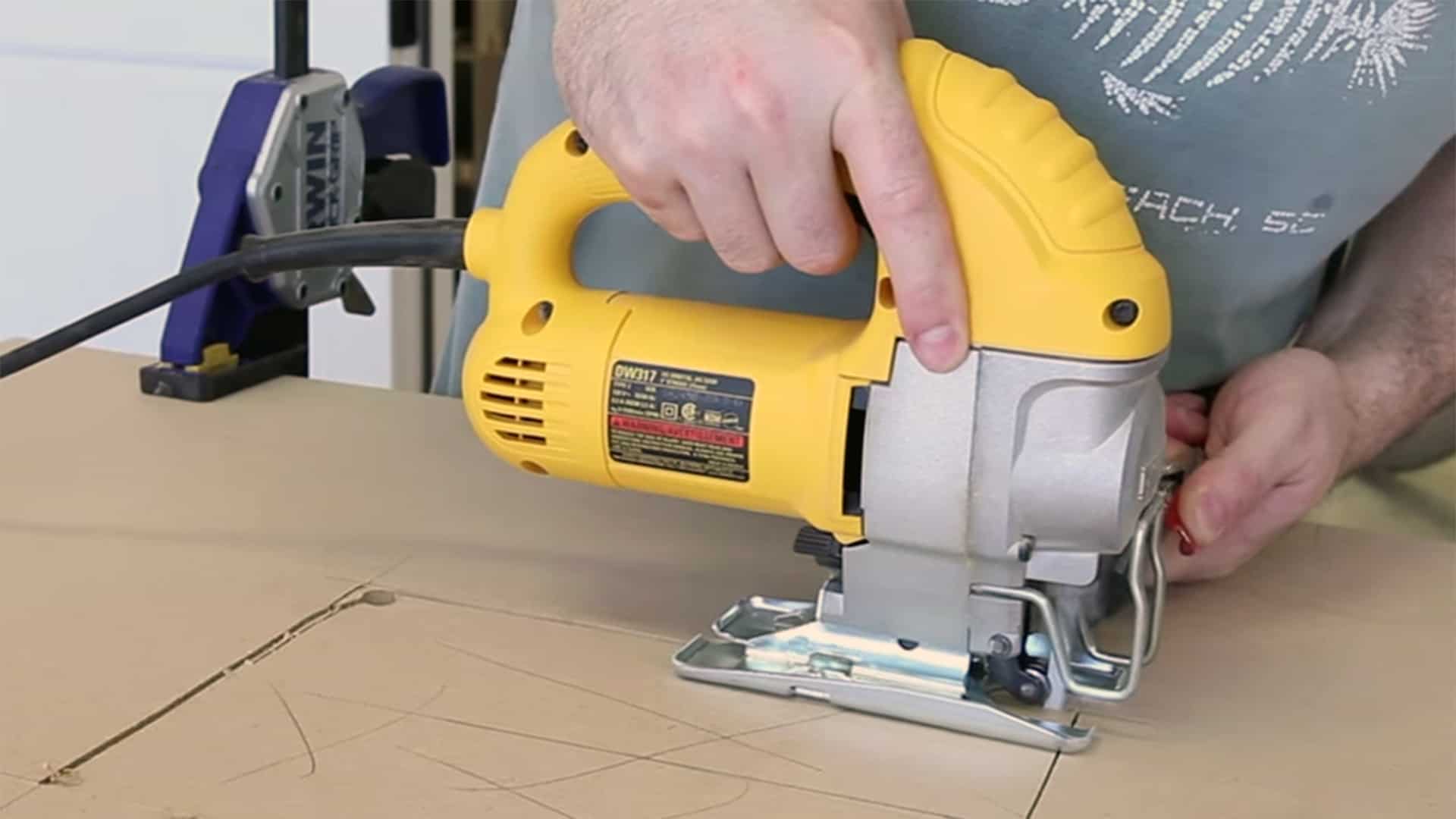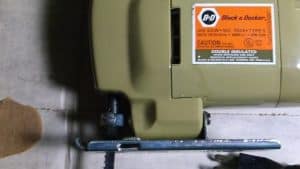Blog
Why Your Jigsaw isn’t Cutting Straight

[adinserter name=”TopOfPost”]A jigsaw is one of the most fundamental tools of every workshop. Yes. I meant to use the word workshop, rather than wood shop. A jigsaw belongs in every shop. Whether you work with wood, metals, plastics, or even papers and cardboard stock you should have a jigsaw in your shop. A jigsaw is very versatile. In addition to cutting all of these different materials, what actually makes it so perfect for every workshop is its ability to cut very intricate designs and patterns. From circles to S-shapes. Just about any shape really. It’s like the handheld bandsaw!
Yet so many workshops are missing this very important tool. And I think its because of one very important reason. Many people equate jigsaws to poor results. Cuts that aren’t straight, that run at a 45 degree angle instead of a 90. There’s this thought “If I use the jigsaw for this cut I am going to spend a lot of extra time sanding out and removing the imperfections. Not worth it.” What if I said we could solve all of that easily.
Your Jigsaw Sucks
 Did I just say that? Yes. Because it does. I can’t tell you how many workshops I’ve been in where the artisan is still using a 1970’s or 1980’s Black and Decker or Craftsman jigsaw. This was literally the stone ages for jigsaws. They’re missing all of the modern features. And all of the important things that make a jigsaw cut straight (I wrote an article on buying the best jigsaw here.). If you’re still using one of these, I want you to walk over to it and toss it into the garbage bin immediately. Then I want you to get in your vehicle and go to the local home improvement store and buy a new one (right after you finish this read). How can you tell if you have one? It probably has a screw that you tighten to hold in the blade, and it lacks a guide bearing.
Did I just say that? Yes. Because it does. I can’t tell you how many workshops I’ve been in where the artisan is still using a 1970’s or 1980’s Black and Decker or Craftsman jigsaw. This was literally the stone ages for jigsaws. They’re missing all of the modern features. And all of the important things that make a jigsaw cut straight (I wrote an article on buying the best jigsaw here.). If you’re still using one of these, I want you to walk over to it and toss it into the garbage bin immediately. Then I want you to get in your vehicle and go to the local home improvement store and buy a new one (right after you finish this read). How can you tell if you have one? It probably has a screw that you tighten to hold in the blade, and it lacks a guide bearing.
To Cut Straight your Jigsaw Needs a Guide Bearing
It wasn’t until the 1990’s that some manufacturers started adding guide bearings to their consumer lines of jigsaws. But without this simple device, its basically impossible for your jigsaw to cut straight or for your jigsaw to cut square! The guide bearing adds a second support point on the blade. This almost completely eliminates and side to side movement of the blade (it can still happen if you turn too sharp, or the blade gets stuck in warped or poorly supported material).
Can you imagine holding your gold club with only one hand? Without the guide bearing there is nothing but the rigidity of the blade to keep it straight. Don’t buy one without this bearing, and don’t buy one that the bearing is flat and without a center groove that the blade fits in (see picture above for what to buy). The jigsaw in this article is a DeWalt DW317K (get it here).
Your Jigsaw Will Only Cut as Straight as the Blade You Choose
 The next most important thing to consider is the quality of the blades you are buying. If you’re buying those cheap jigsaw blades from Wal-Mart, you’ve already failed! Look for the better quality blades at your local wood store, home improvement centers, or from Amazon.com.
The next most important thing to consider is the quality of the blades you are buying. If you’re buying those cheap jigsaw blades from Wal-Mart, you’ve already failed! Look for the better quality blades at your local wood store, home improvement centers, or from Amazon.com.
Higher quality blades aren’t just thicker, but also made out of more rigid alloys and will stay shaper much longer. You almost always loose when you buy the cheap stuff in life, and this just another example. The good blades will save you time and money in the end. So don’t be fooled.
With the combination of a good quality jigsaw with a quality guide bearing and quality blade, you’ll be well on your way to the perfect jigsaw cut every time. If you want to see what a quality jigsaw cut looks like, watch my How to Make an Arcade Cabinet video (Part 1). The entire face of the cabinet was cut with a jigsaw, by hand.
The Best Jigsaws
If you’re looking to learn more about jigsaws or interested in buying one, check out my article on the Top 3 Jigsaws money can buy! You might be surprised to find out that they aren’t as expensive as you might think.



I have a DeWalt DW321 which worked well for over a year. Suddenly it started cutting crooked. I only use Bosch or DeWalt blades. To make a straight cut (follow a line), I literally have to aim the tool slightly to the right. This tool has not been used or abused to the point that it should show any wear.
I suspect the guide bearing is worn. It’s probably so small you can’t see it, but is amplified over a large area.
Necrothread…but, my blades have always jumped out of the guide bearing since new. If I’m cutting anything over a 1/2″ thick, there will be a curve on the lower side of the wood, no matter what quality blade or how slow I go. Look at it wrong, and the blade jumps the bearing.
Hello,
and thank you for your advise on cutting straight with a jigsaw.
You wrote “It wasn’t until the 1990’s that some manufacturers started adding guide bearings to their consumer lines of jigsaws.”
I do have a Black & Decker DN35 from the mid 70s that already has a guide bearing wheel, even though it is a relatively small one compared to my newer jigsaws. A nice, small machine that still works and gives perfectly straight cuts.
Of course it is much louder than my two new machines; there is noticeable more vibration, and it has only one speed. It also lacks of fancy features like pendulum action, dust blower, work light or laser. On the pro side, it has a highly flexible rubber cable instead one made from PVC.
Kind regards
Peter
I bought a Maximum orbital jigsaw. I cuts great, but not in the correct direction.
The blade goes to the right of the laser line and pulls to the right of a straight edge. Holding it against the straight edge makes the blade start to bend. There is no mention of this in trouble shooting.
I have the same issue and am looking for an answer…I have the issue when cutting a 1/2″ Polyethylene sheet, ruined several expensive projects.
having the same issue with mine even after minimal use
5
I have that exact Black and Decker jigsaw as the photo… given to me as a gift in 1980 or so. It makes beautiful cuts… a 2-foot cut in 3/4 plywood with a guide perfectly on the line at both beginning and end, and square all the way down the cut. My NEW Black & Decker, WITH the guide bearing, with a guide, at the end of a seven-inch cut in clear 1-inch pine stock the cut had pulled over 1/4′ to the left of the guide line. Freehand I have to angle it several degrees to the right to stay on the line, and the cut is more and more off-square the farther I go.
I bought a jigsaw thinking it can do all cuts compared to a circular saw that can only cut straight. I didn’t know the jigsaw blade can move side to side making it difficult to achieve straight cuts (mine has the guide bearing). Now I realised I don’t really cut curves in my projects and should have gone for the circular saw.
0.5
3
1
For me, it’s all about WOOD. Keeping the blade cutting straight up and down has always been a challenge– with my 1979 Craftsman jigsaw, and even with the newer Ryobi model I purchased in 2019. The new one does have the guide bearing with a groove. I have a few sizes of Bosch bits, some narrow, some wide. On important cuts, I try to move the saw slowly so as not to twist the blade– but it is still a challenge to get a straight up-and-down cut.
I dont have a problem with cabinet panels or 3/4′ stock. BUT if I try to cut a ‘two by’ it is totally hopeless. I was trimming a door down with my jig saw and it cut at an angle, ruining an expensive wooden door. Instead of going natural finish. I had to table saw straight, add a shim and paint the door. Why dont they just manufacture thicker blades for straight cuts? DUH. I am going to epoxy or solder two blades together, cutting one off where it fits into the holding device and experiment with that. I cant afford any more unintended angle cuts with my jig saw!
1.5
There’s a saying… “it’s a poor workman that blames his tool”. For cutting a 2x… you need a circular saw for trimming a door.
Recently purchased a AEG 700watt jigsaw and its butchered some good timber. I can get a straight cut if I’m really careful without much tear out. However the problem lies with trying to square the foot to the blade.
It seems to be an impossible task. The blade itself is positioned rotated slightly to the left, also nowhere near the centre of the foot and was in this position when I bought it. Both the blade holder and the guide have too much play so they are easily pushed out of place. Yep it always bevels partly for these reasons.
Thicker blades help a lot for straight cutting as they bend and flex less. Bosch precision are good but will not stop the beveling as the blades cannot be squared to the base. As for the new jigsaws been better? I’ve seen a lot of comments online from people who have used jigsaws for 20 – 40 years without problems and cant believe how bad the new models are.